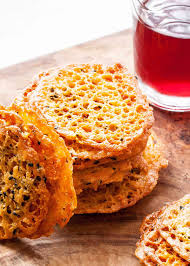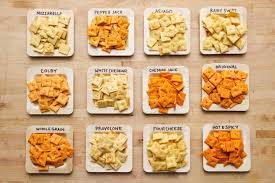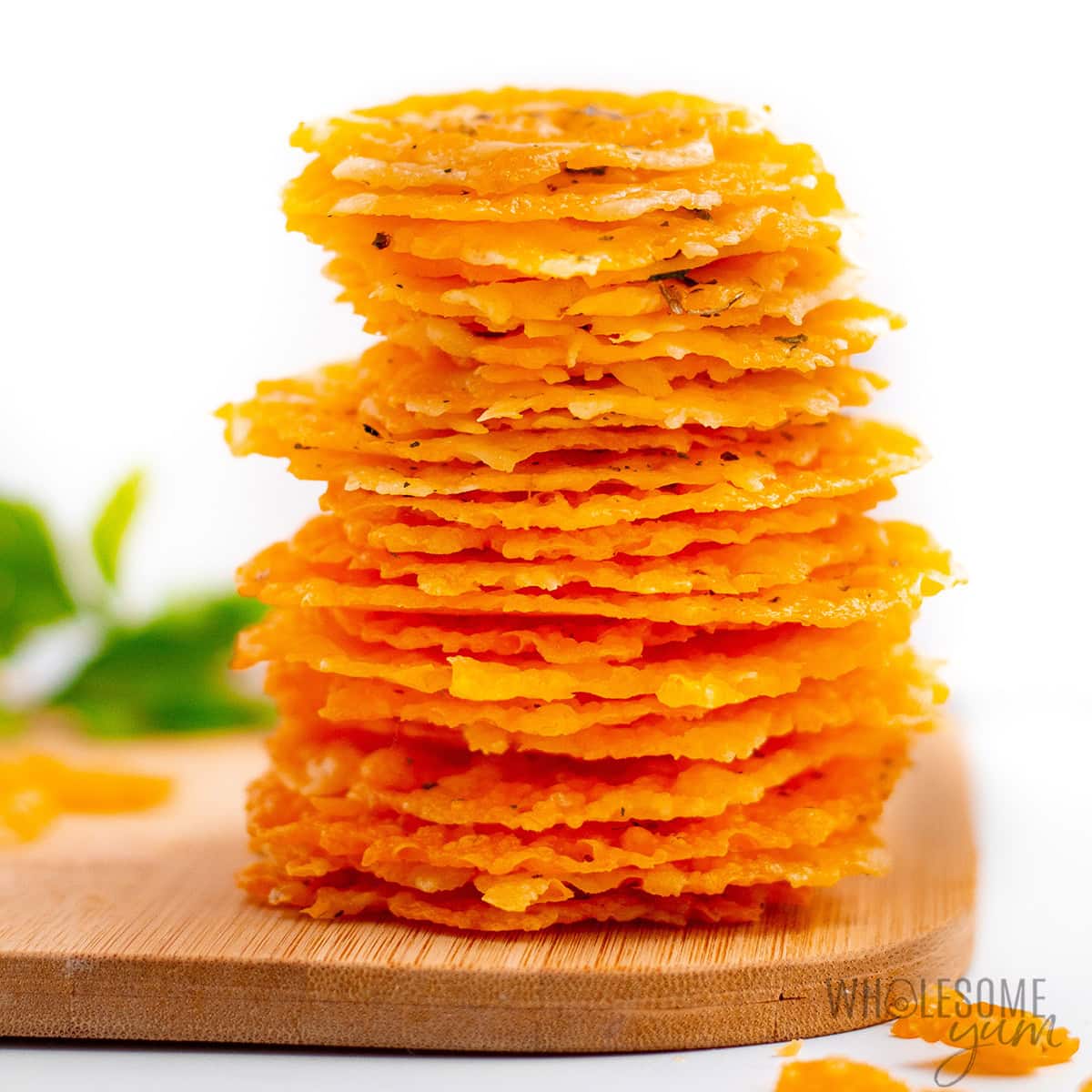In a world overflowing with snack options, few things rival the simple yet irresistible allure of cheese crisps. These golden, crunchy delights transform ordinary cheese into a gourmet treat that’s perfect for any occasion—whether you’re hosting a party, seeking a low-carb alternative to chips, or just craving something savory.
Cheese crisps have surged in popularity, especially among health-conscious eaters and those following keto or gluten-free diets. Unlike traditional potato chips laden with carbs and preservatives, cheese crisps deliver pure, unadulterated cheese goodness. On our website, we’ve covered similar snacks like our Keto-Friendly Appetizers, which pair wonderfully with these crisps. Externally, sites like Allrecipes offer endless inspiration for cheesy creations.

A stack of golden cheddar cheese crisps, perfect for snacking.
What makes cheese crisps so special? Their simplicity belies a rich texture and flavor profile—crispy edges, a slight chew in the center, and the natural saltiness of cheese. They can be enjoyed plain or enhanced with herbs, spices, or even toppings like jalapeños for a spicy kick. As we delve deeper, we’ll uncover the origins of this snack, its nutritional perks, and practical tips to achieve perfection every time. Whether you’re a novice in the kitchen or a seasoned chef, cheese crisps are an accessible way to indulge without guilt.
The History of Cheese Crisps: From Ancient Origins to Modern Munchies
The story of cheese crisps is as layered as the snack itself, spanning continents and centuries. At its core, the concept of crisping cheese dates back to ancient times when early cheesemakers discovered that heating cheese could create a crunchy byproduct. In Italy, frico—a traditional dish from the Friuli region—serves as one of the earliest documented forms of cheese crisps. Made by frying or baking grated Parmigiano-Reggiano or Montasio cheese, frico originated as a way to repurpose cheese rinds and scraps during lean times. Historical records suggest frico has been enjoyed since the Middle Ages, often served with polenta or as a standalone appetizer.
Across the Atlantic, cheese crisps took on a distinctly American twist. In the southwestern United States, particularly Arizona, the “Arizona cheese crisp” emerged in the mid-20th century. This version involves a large flour tortilla topped with shredded cheese and broiled until bubbly and crisp. Its origins are tied to Mexican-American cuisine, with influences from quesadillas but distinguished by its open-faced style. According to local lore, Tucson restaurants like El Guero Canelo popularized it in the 1950s, though exact origins remain debated. The name “cheese crisp” likely stems from the crunchy texture achieved by baking rather than frying.
The modern baked cheese crisp, popularized in low-carb diets, gained traction in the 21st century. Brands like Whisps and ParmCrisps commercialized the idea, drawing from frico traditions but marketing them as healthy snacks. The keto boom in the 2010s propelled their popularity, as people sought carb-free alternatives to chips. Meanwhile, cheese puffs—a puffed, extruded variety—have a separate industrial history. Invented in the 1930s at the Flakall Company in Wisconsin, they were accidentally created while processing animal feed. Edward Wilson noticed the machine produced puffed corn coated in cheese, leading to the birth of cheese curls like Cheetos.
Globally, variations abound. In Ireland, Tayto introduced flavored crisps in 1954, including cheese and onion, revolutionizing the snack industry. The UK’s crisps market, starting with Smith’s in 1920, added spices early on. Today, cheese crisps blend these influences, from artisanal baked versions to mass-produced puffs. For more on frico’s roots, check out https://tastetrove.net/. On our site, explore The Evolution of Snacks for related reads.
Production methods have evolved too. Traditional frico is handmade, while commercial crisps use high-tech ovens to achieve uniform crispiness. Environmentally, sustainable cheese sourcing is key, as highlighted by USDA dairy reports.

Homemade cheese crisps fresh from the oven.
This historical tapestry shows cheese crisps as more than a snack—they’re a cultural fusion, adapting to tastes worldwide.
Health Benefits of Cheese Crisps: A Nutritious Crunch
Beyond their addictive taste, cheese crisps pack a nutritional punch, making them a smart choice for mindful snacking. Primarily made from cheese, they’re naturally high in protein and low in carbs, ideal for keto, paleo, or gluten-free lifestyles. A serving of two crisps (about 2 tablespoons) can provide up to 10 grams of protein, supporting muscle repair and satiety. Cheese is also an excellent source of calcium, with one serving delivering a significant portion of your daily needs for bone health.
The fats in cheese crisps are mostly healthy saturated and monounsaturated types, contributing to heart health when consumed moderately. Studies from the https://tastetrove.net.indicate that full-fat dairy may not increase heart disease risk as once thought, and could even aid weight management by promoting fullness. For keto dieters, they’re a godsend—zero net carbs in plain versions, helping maintain ketosis while curbing cravings for crunchy foods.
Antioxidants and probiotics in aged cheeses like cheddar or Parmesan support gut health, potentially improving digestion and immunity. Berries or nuts added to variations boost fiber and vitamins, creating a balanced snack. However, watch sodium levels; opt for low-sodium cheeses to avoid excess salt.

Variety of cheese crisps showcasing nutritional appeal.
Specific benefits include:
- Weight Management: High protein and fat content reduce hunger, aiding calorie control.
- Bone Strength: Rich in calcium and vitamin D (if fortified).
- Muscle Support: Essential amino acids from cheese promote recovery post-exercise.
- Blood Sugar Stability: Low glycemic index prevents spikes.
For athletes or busy professionals, they’re a portable energy source. Even Dr. Michael Mosley endorses cheese-based snacks for their health profile. Drawbacks? High calories if overeaten, so portion control is key. Vegan? Try nut-based alternatives, though they differ in nutrition.
Incorporating cheese crisps can enhance your diet—link to our Healthy Snack Ideas for more.
Breaking Down the Ingredients: What Makes Cheese Crisps Shine
Quality ingredients are the foundation of great cheese crisps. Start with cheese: Hard varieties like cheddar, Parmesan, or Asiago work best, as they melt and crisp without excess oil. Cheddar offers a sharp, tangy flavor; Parmesan, a nutty depth. Avoid soft cheeses like mozzarella, which can become chewy.
Add-ins elevate the basic recipe: Herbs (rosemary, thyme), spices (paprika, garlic powder), or seeds (sesame, everything bagel seasoning) for crunch and flavor. For Arizona-style, use flour tortillas and shredded Mexican blend cheese.
Sourcing: Opt for organic, rBST-free cheese for better taste and ethics. Brands like Sonoma Creamery specialize in crisp-friendly options.

Assortment of cheese types for crisps.
Each element contributes: Cheese for protein, spices for antioxidants.
Step-by-Step Recipe for Classic Cheese Crisps
Making cheese crisps is effortless. Here’s a basic recipe for 12 crisps:
- Preheat oven to 400°F (200°C). Line a baking sheet with parchment paper.
- Shred 1 cup of cheddar or Parmesan cheese.
- Spoon 1-2 tablespoons of cheese into mounds on the sheet, spacing 2 inches apart.
- Flatten slightly; add seasonings if desired.
- Bake 5-7 minutes until golden and bubbly.
- Cool on the sheet for crispiness.
Prep: 5 min. Cook: 7 min. Calories: ~110 per crisp.

Bowl of seasoned cheese crisps.
Microwave option: Place on parchment, cook 1-2 min.
Creative Variations on Cheese Crisps
Experiment with these:
- Spicy Jalapeño: Top with sliced peppers.
- Herb-Infused: Mix in rosemary or basil.
- Everything Bagel: Sprinkle seasoning.
- Arizona Style: Broil cheese on tortilla.
- Vegan Twist: Use nutritional yeast blends.

Scattered flavored cheese crisps.
External inspiration: Wholesome Yum variations.
Tips and Tricks for Perfect Cheese Crisps
- Use parchment to prevent sticking.
- Watch closely to avoid burning.
- Cool completely for max crunch.
- Store in airtight container up to a week.
More tips in our Baking Hacks.
Nutritional Information and Analysis
A standard serving (28g): 160 calories, 14g protein, 12g fat, 1g carbs. Adjust for add-ins. Use MyFitnessPal for tracking.
Crunch Into Cheese Crisps Today
Cheese crisps are a timeless, healthy snack. Try them and visit More Recipes on our site.The History of Greek Yogurt and Parfaits: A Timeless Tradition
Greek yogurt’s story begins around 5000 BCE in Mesopotamia, where fermented milk was discovered by nomadic herders. The straining process, which defines Greek yogurt’s thick texture, likely emerged in the Mediterranean, earning it the name “straggisto” in Greece. Ancient texts, including those by Hippocrates, praised yogurt for its digestive benefits, a nod to its probiotic content. By the 20th century, Greek immigrants brought the recipe to North America, and brands like Fage commercialized it in the 1990s. Chobani’s launch in 2005 made it a household name, with production involving fermentation and triple-straining, as detailed by Dairy Management Inc..
The parfait, derived from the French word for “perfect,” started as a frozen dessert in 19th-century France, layered with ice cream and fruits. In the 1960s, American health food culture reimagined it with yogurt, aligning with the fitness boom. Berries—strawberries, blueberries, raspberries—became stars due to their antioxidant properties, with roots in Roman strawberry cultivation and Native American blueberry use. Learn more in our History of Berries in Cuisine or this YouTube documentary on yogurt’s origins.
Today, parfaits are a global sensation, from cafes to Instagram feeds. Sustainable dairy practices, like repurposing whey for protein supplements, are gaining traction, per USDA sustainability reports. This blend of ancient and modern makes the parfait a timeless delight.
Health Benefits: A Nutritional Powerhouse
The Greek Yogurt Berry Parfait shines for its health benefits, combining protein, antioxidants, and fiber. Here’s the breakdown:
- Greek Yogurt: A cup (240g) delivers 15-20g of protein, supporting muscle repair and satiety. Its probiotics boost gut health, immunity, and mental wellness via the gut-brain axis, as noted by the National Institutes of Health. It’s also rich in calcium (20% daily value) and vitamin D (if fortified) for strong bones.
- Berries: Strawberries, blueberries, raspberries, and blackberries offer 50-80 calories per cup, 6-8g fiber, and antioxidants like anthocyanins, which reduce inflammation and heart disease risk.
- Granola/Nuts: Provide healthy fats and fiber, enhancing fullness. Choose low-sugar granola or nuts like almonds for heart health.
A 300g parfait offers 300-400 calories, 20g protein, 40g carbs, and 10g fat, ideal for weight management, diabetes control, or post-workout recovery. Key benefits:
- Weight Loss: Protein and fiber curb hunger.
- Heart Health: Berries lower cholesterol and blood pressure.
- Digestive Health: Probiotics balance gut flora.
- Skin Benefits: Vitamin C supports collagen; yogurt’s lactic acid aids skin health.
It’s perfect for athletes (glycogen and muscle repair) and pregnant women (folate, calcium). Watch for added sugars in store-bought yogurt; opt for plain. Dairy-free? Try coconut yogurt, though protein may be lower. More on our Berry Health Benefits page.
Ingredients: Crafting the Perfect Parfait
Quality is king:
- Greek Yogurt: Plain, full-fat, or low-fat. Fage or Chobani are top picks. Full-fat is creamier; low-fat cuts calories.
- Berries: Fresh or thawed frozen strawberries, blueberries, raspberries, blackberries. Organic minimizes pesticides.
- Granola: Low-sugar, oat-based, or homemade. Nuts/seeds (chia, flax) add crunch.
- Sweeteners: Honey, maple syrup, or agave.
- Add-Ins: Mint, coconut, or nut butter.
Source berries locally and try our Homemade Granola Recipe.
5 Nutritious Greek Yogurt Berry Parfait Recipes
These five recipes cater to diverse tastes and diets. Each serves 2, preps in 10 minutes.
1. Classic Greek Yogurt Berry Parfait
Ingredients:
- 2 cups plain Greek yogurt
- 1 cup mixed berries
- ½ cup low-sugar granola
- 2 tbsp honey
- Mint sprigs
Instructions:
- Layer ¼ cup berries in two glasses.
- Add ½ cup yogurt, then 2 tbsp granola.
- Repeat layers.
- Drizzle honey; garnish with mint.
Nutrition: ~350 calories, 20g protein, 40g carbs, 10g fat, 4g fiber.
2. Tropical Mango-Pineapple Parfait
Ingredients:
- 2 cups coconut Greek yogurt
- ½ cup diced mango
- ½ cup diced pineapple
- ½ cup coconut granola
- 2 tbsp agave syrup
Instructions:
- Layer mango and pineapple in jars.
- Add ½ cup yogurt, 2 tbsp granola.
- Repeat; drizzle agave.
Nutrition: ~380 calories, 18g protein, 45g carbs, 12g fat, 5g fiber.
3. Chocolate-Berry Indulgence Parfait
Ingredients:
- 2 cups vanilla Greek yogurt
- 1 cup mixed berries
- ¼ cup dark chocolate chips
- ½ cup chocolate granola
- 1 tbsp maple syrup
Instructions:
- Layer berries and yogurt.
- Sprinkle chips and granola.
- Repeat; drizzle maple syrup.
Nutrition: ~420 calories, 18g protein, 50g carbs, 15g fat, 6g fiber.
4. Vegan Berry Bliss Parfait
Ingredients:
- 2 cups almond yogurt
- 1 cup mixed berries
- ½ cup gluten-free granola
- 2 tbsp maple syrup
- 2 tbsp chia seeds
Instructions:
- Mix chia into yogurt.
- Layer berries, yogurt, granola.
- Drizzle maple syrup.
Nutrition: ~340 calories, 10g protein, 45g carbs, 12g fat, 7g fiber.
5. Pumpkin Spice Fall Parfait
Ingredients:
- 2 cups plain Greek yogurt
- ½ cup pumpkin puree
- 1 cup mixed berries
- ½ cup cinnamon granola
- 1 tsp pumpkin spice
- 2 tbsp honey
Instructions:
- Mix pumpkin and spice into yogurt.
- Layer berries, yogurt, granola.
- Top with honey.
Nutrition: ~360 calories, 20g protein, 42g carbs, 10g fat, 5g fiber.
More ideas at Healthline’s parfait guide or this recipe video.
